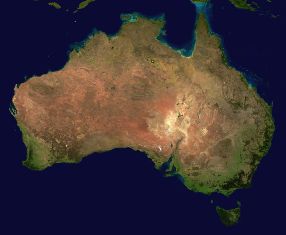 Australia's economically demonstrated resources of uranium (EDR, recoverable for less than $80 per kg) at the end of 2006 were 714,000 tonnes (tU). During the year, exploration and development drilling resulted in increases at several locations which took the total to 953,000 tU total.
Australia's economically demonstrated resources of uranium (EDR, recoverable for less than $80 per kg) at the end of 2006 were 714,000 tonnes (tU). During the year, exploration and development drilling resulted in increases at several locations which took the total to 953,000 tU total.If 'inferred' resources are added, the total comes to 1.53 million tonnes recoverable at less than $80 per kg, as of August 2007. This compares with the figure of 1.143 million tU published in Uranium Resources, Production and Demand at end of 2004. The publication, from the OECD Nuclear Energy Agency and the International Atomic Energy Agency is the nuclear industry standard, often known by its nickname: the Red Book.
Reclassification by BHP Billiton of some of its Olympic Dam resources from EDR to inferred in 2006 reflected a conservative approach to mineralisation on the southeast of the deposit "where current drilling is defining large tonnages of additional resources." This reclassification resulted in a slight decrease in Australian EDR from the end of 2005 to the end of 2006.
Approximately 96% of Australia's EDR is within six deposits: Olympic Dam (the world's largest known uranium deposit), Ranger, Jabiluka, Koongarra, Kintyre and Yeelirrie. Australia had 27% of the world's uranium (recoverable for up to $80 per kg) at end of 2006, although no estimate is possible for August 2007 in the absence of corresponding international data.
The new report makes a distinction between EDR and 'accessible EDR', to reflect the fact that state government policies in Queensland and Western Australia plus aboriginal policies in the Northern Territory currently make 21% of Australia's EDR inaccessible for mining.
Despite these restrictive policies and perhaps in anticipation of their disappearance, uranium exploration gathered pace during 2006, with more than 200 companies professing an interest, compared with 34 the previous year. Expenditure almost doubled, to A$80.7 million ($71.8million) and has continued to increase since, to A$114 million ($101 million) in 2006-7. Significant discoveries include extensions to Olympic Dam and Valhalla, and the Beverley Four Mile deposit.
Further information
Geoscience Australia: Australia's Identified Mineral Resources 2007
WNA's Australia's Uranium and Who Buys it information paper
AUA's Uranium Mining in Australia information papers





_69614.jpg)

_15447.jpg)




